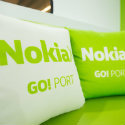The Finnish equipment vendor is adding new features to one of its most important enterprise services.

App stores have been a godsend for the indolent consumer, allowing him to buy smartphone goodies with just the laziest swipe of a thumb.
Companies have been taking the same model into the business market, and the latest to do so is Nokia.
The Finnish equipment vendor has been one of the frontrunners in the market for private wireless networks – built for an individual campus or factory and kept separate from an operator's public network.
Now it is adding new app features to its Digital Automation Cloud (DAC) service, one of two broad offerings for organizations that want a private wireless network.
DAC customers entrust service management to Nokia or another partner but also install an edge cloud server directly on their premises.
That guarantees reliability and local data breakout. It also provides access to what Nokia calls the DAC cloud manager.
"It's an app catalog we are expanding … something similar to what you would see with the App Store or Play Store," says Stephan Litjens, the general manager of digital automation for Nokia, referring to the popular consumer stores maintained by Apple and Google.
Right now, the focus is on providing a core number of voice and data apps developed mainly by Nokia.
But there is support for Internet of Things services from Microsoft Azure, and "plug-ins" to other cloud providers – such as AWS Greengrass – are in the works.
"We are not yet talking about bring-your-own apps, but I can say that is something we are working heavily on," says Tuuli Ahava, the head of Nokia DAC applications.
Although it might not equate to winning a 5G radio contract with a Tier 1 operator, the new venture should bring additional revenues for Nokia's software-as-a-service business.
Following the update, DAC customers will be able to select new features through a graphical user interface.
"Then it goes back to our subscription-based business model and there are mechanisms for how we charge," says Ahava.
Nokia says it already has customers using some of the new services, although it is not disclosing their identities at this stage.
Want to know more about 5G? Check out our dedicated 5G content channel here on
Light Reading.
It has also secured the endorsement of a highly respected industry analyst.
"Packaged solutions such as Nokia's DAC platform will be key to unlocking the private network opportunity in future," said Caroline Chappell, a research director at Analysys Mason, in Nokia's official blurb.
"Enterprises require simple, easy-to-use and cost-effective private network solutions that integrate connectivity, cloud and vertical-specific applications," she added. "Increasingly there is demand for solutions that resolve industry-specific challenges such as protocol translation."
All this will burnish Nokia's reputation in the software market.
While the company has had a series of missteps when it comes to the much bigger 5G radio business, its relatively young software division has been on a roll.
Despite a revenue slowdown this year, largely blamed on the coronavirus pandemic, it has been able to land some important deals, including a contract this week to provide the 5G core for Dish Network, the US operator now building a fourth mobile network.
That win could be of major strategic importance, not least because Marc Rouanne, Dish's chief networks officer, says Nokia has been through "multiple checks" to make sure its software lives up to its "cloud-native" claims.
Based on containers and microservices, this cloud-native software has proven critical for the latest apps innovation, insists Ahava.
"We don't need to send anyone to install something somewhere," she says.
Related posts:
— Iain Morris, International Editor, Light Reading
Read more about:
EuropeAbout the Author(s)
You May Also Like










